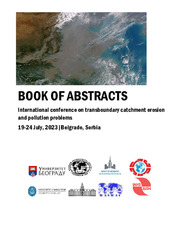Приказ основних података о документу
Territory of Serbia as Indicator of Transboundary and Domestic Waters of Southeastern Europe
| dc.creator | Milinčić, Miroljub | |
| dc.creator | Vukoičić, Danijela | |
| dc.creator | Jovanović Popović, Dejana | |
| dc.creator | Ristić, Dušan | |
| dc.creator | Mihajlović, Ljiljana | |
| dc.creator | Petrović, Dragan | |
| dc.date.accessioned | 2023-10-18T12:37:06Z | |
| dc.date.available | 2023-10-18T12:37:06Z | |
| dc.date.issued | 2023 | |
| dc.identifier.isbn | 978-5-89575-265-4 | |
| dc.identifier.uri | http://gery.gef.bg.ac.rs/handle/123456789/1494 | |
| dc.description.abstract | Water is an essential determinant of natural, social and landscape characteristics. It generates opportunities and limitations, chances and threats, negative and positive phenomena and processes including environmental, economic, political, social as well technical aspects. Problems relating to water security, water protection, equitable access to water as well as upstream and downstream interests are increasingly present from micro to macro level. Such trends are recognized in Southeastern Europe, with regional and local specificities conditioned by natural, social, geopolitical and other characteristics. Although relatively rich in water resources, the region shows a high degree of sensitivity and vulnerability. The causes are numerous, and most often they are recognized in the unfavorable natural regime of waters, poor ecological status, geopolitical and interest driven fragmentation of space, climate changes, and lack of development of water management infrastructure. Unfortunately, floods (May-June) and droughts (July-August) are almost regular seasonal occurrences in Serbia, often with catastrophic consequences. Floods are frequent, from overflowing rivers with predominantly transboundary waters (Tamiš – 2005, Danube 2006 and 2013) as well as domestic ones (Velika Morava – 2005, Nišava, Vlasina and Jablanica – 2007, Zapadna Morava and Veliki Rzav – 2009, Timok – 2010 etc.). The floods in 2014 were particularly disastrous, with estimated economic damage of 1.7 billion euros, and also in 2023. Floods, as a rule, cause landslides that threaten population, settlements, infrastructure, agricultural areas and crops. Droughts are a frequent phenomenon during summers (2000, 2003, 2009, 2011, 2015, 2021, 2022), causing serious disruption of agricultural and manufacturing industries, drinking water supply, energy and, in extreme cases, inland waterway transportion system. As for Serbia, the state and assessment of water resources are a basic segment of quality and capacity of environment, but also the perspective of existence and overall development of society. The territory of Serbia offers a good field for research of trends of change in the quality and quantity of transboundery and domestic waters in Southeast Europe. | sr |
| dc.language.iso | en | sr |
| dc.publisher | Moscow : Lomonosov Moscow State University - Faculty of Geography | sr |
| dc.rights | openAccess | sr |
| dc.rights.uri | https://creativecommons.org/licenses/by/4.0/ | |
| dc.source | Book of abstract of the International conference on transboundary catchment erosion and pollution problems, Belgrade | sr |
| dc.subject | Serbia | sr |
| dc.subject | Southeast Europe | sr |
| dc.subject | transboundary waters | sr |
| dc.subject | water management | sr |
| dc.subject | flood | sr |
| dc.subject | drought | sr |
| dc.title | Territory of Serbia as Indicator of Transboundary and Domestic Waters of Southeastern Europe | sr |
| dc.type | conferenceObject | sr |
| dc.rights.license | BY | sr |
| dc.citation.spage | 12 | |
| dc.citation.epage | 12 | |
| dc.identifier.fulltext | http://gery.gef.bg.ac.rs/bitstream/id/3344/bitstream_3344.pdf | |
| dc.identifier.rcub | https://hdl.handle.net/21.15107/rcub_gery_1494 | |
| dc.type.version | publishedVersion | sr |


